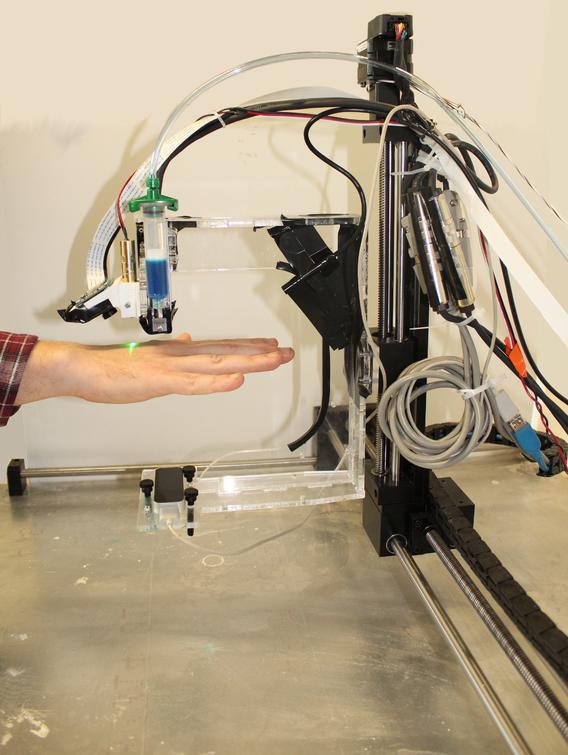Since the first organ transplant in the mid twentieth century, countless lives have been saved due to human organ donation and transplantation. Nevertheless, the lives saved through this procedure is inherently limited by the number of organs available. Recent research has posed a possible solution to this problem by combining tissue engineering with additive manufacturing, yielding the ability to 3D print a tissue scaffold of human anatomical organs for transplant. Our lab seeks to extend this research even further by investigating the possibility of 3D printing directly onto unpredictably moving human anatomy. The goal of this research is to provide surgeons with the ability to print tissue onto other tissue, e.g. printing a skin graft directly onto a patient without limiting the patient’s range of motion. In order for this idea to become a reality, multiple challenges have to be addressed, including motion tracking, printing on a non-rigid moving surface, and the inherent tradeoff between print speed and accuracy. The current researchers for this project are Rebecca Smith and Reed Johnson. Previous researchers include John O'Neill, Rodney Dockter and Anna French.
3D Bioprinting Directly Onto Moving Human Anatomy
Relevant Publications:
| [1] | Anna French, John O'Neill, Ryan Madson, and Timothy M Kowalewski. Dynamic Additive Manufacturing onto Free-moving Human Anatomy via Temporal Coarse/Fine Control. In Medical Robotics (ISMR), 2018 International Symposium on, pages 1--6. IEEE, 2018. [ .pdf ] |
| [2] | Reed A. Johnson, John J. O'Neill, Rodney L. Dockter, Carl J. Modl, Daniel Sorby, Angela Panoskaltsis-Mortari, and Timothy M. Kowalewski. Comparison of bio-inks for free-hand 3d bioprinting directly onto moving human anatomy. In The Hamlyn Symposium on Medical Robotics, 2018. [ .pdf ] |
| [3] | Rebecca G. Smith, Reed A. Johnson, Gabriella Shull, Daniel Sorby, Carl J. Modl, Angela Panoskaltsis-Mortari, and Timothy M. Kowalewski. Towards robotic bioprinting directly onto moving, stretching anatomy. In The Hamlyn Symposium on Medical Robotics, 2018. [ .pdf ] |
| [4] | Reed A. Johnson, John J. O'Neill, Rodney L. Dockter, and Timothy M. Kowalewski. Toward inkjet additive manufacturing directly onto human anatomy. In 2017 Design of Medical Devices Conference, pages V001T11A023--V001T11A023. American Society of Mechanical Engineers, ASME Digital Collection, 2017. [ .pdf ] |
| [5] | John J O'Neill, Reed A Johnson, Rodney L Dockter, and Timothy M Kowalewski. 3D Bioprinting Directly onto Moving Human Anatomy. In 2017 IEEE/RSJ International Conference on Intelligent Robots and Systems (IROS), pages 934--940. IEEE, 2017. [ .pdf ] |
| [6] | Rebecca Smith, John O'Neill, and Timothy M. Kowalewski. 3D Bioprinting Directly onto Unpredictably-Moving Human Anatomy: Can Dynamic Vision Sensors Improve Performance? In IEEE IROS Full-day Workshop on Continuum Robots in Medicine - Design, Integration, and Applications, 2017. [ .pdf ] |
| [7] | Anna French, John O'Neill, and Timothy M Kowalewski. Design of a Dynamic Additive Manufacturing System for Use on Free-moving Human Anatomy. ASME Journal of Medical Devices, 10(2):020941, 2016. [ .pdf ] |
